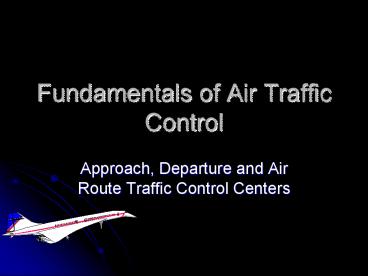Fundamentals of Air Traffic Control - PowerPoint PPT Presentation
1 / 25
Title:
Fundamentals of Air Traffic Control
Description:
Fundamentals of Air Traffic Control Approach, Departure and Air Route Traffic Control Centers Terminal Radar Approach Control (TRACON) At busy facilities that have ... – PowerPoint PPT presentation
Number of Views:2891
Avg rating:3.0/5.0
Title: Fundamentals of Air Traffic Control
1
Fundamentals of Air Traffic Control
- Approach, Departure and Air Route Traffic Control
Centers
2
Terminal Radar Approach Control (TRACON)
- At busy facilities that have been delegated a
large amount of airspace, an approach and
departure control position is usually designated
3
Terminal Radar Approach Control (TRACON)
- At smaller airports, one controller may be
responsible for radar approach - At larger facilities, as many as 40 controllers
may be manning scopes - Some TRACONS controllers may be assigned to tower
and approach
4
TRACON Video Map
5
TRACON SECTOR DELEGATED AIRSPACE
TRACON Sector Delegated Airspace
6
Air Route Traffic Control Centers
- 21 air route traffic control centers in the
united states - Each center is broken into smaller areas called
sectors - Low altitude sectors (surface to FL180)
- High altitude sectors (FL180 to FL600)
7
Air Route Traffic Control Center (ARTCC)
21 ARTCCs 3 CERAPs (combined Center RAPCONs)
A facility established to provide air
traffic control service to aircraft
operating on IFR flight plans within
controlled airspace and principally during
the en route phase of flight. At some
airports not served by an Approach Control
facility, the ARTCC provides limited
approach control service. When equipment
capabilities and controller workload permit,
certain advisory/assistance services may be
provided to VFR aircraft. Air Traffic
Control Manual Order 7110.65
Pilot/Controller Glossary
8
Airspace Orientation
Fort Worth ARTCC
15 High Altitude Sectors
FL 240 Above
LBB
MAF
9
Airspace Orientation
Fort Worth ARTCC
18 Low Altitude Sectors
FL 230 Below
10
US Airspace Sector Structure
Slide courtesy of Prof. J. Hansman
11
Air Route Traffic Control Centers
High altitude ARTCC sectors
12
Air Route Traffic Control Centers
Low-Altitude ARTCC sectors
13
Air Route Traffic Control Centers
- Controller duties in an air route traffic control
center - Flight data controller
- Radar controller
- Radar associates/Nonradar controllers
14
ARTCC ATC Positions
RADAR or R Position
Radar Associate or D Position
Assistant or ATA Position
Hand-off/ Tracker Position
- Teamwork
- Flexibility
- Technique
15
Center Controllers
- Each sector has a team of 1 to 3 controllers
assigned - Safely and efficiently move traffic along their
planned routes - Merge, setup flights for delivery to next
facility - Must get/give permission to hand-off/receive
aircraft - In quiet periods, contiguous sectors may be
combined - Each area has an area supervisor
- In traffic management unit, traffic management
coordinators make strategic decisions about flows - eg, based on weather and available runways, set
TRACON arrival rates (aircraft/hour) - Coordinate flow parameters with adjacent
facilities
16
Air Route Traffic Control Centers
- Flight Data Controllers
- First position controller learns in center
- Responsible for assisting other controllers
- Effects coordination with other controllers
- Passes along pertinent flight information to
controllers working in other sectors - Like the tower position, FD is the person who
keeps the paperwork up
17
Air Route Traffic Control Centers
- Radar controllers
- Responsible for separating participating aircraft
utilizing a radar-derived display - Issue altitude, heading, or airspeed changes to
keep the aircraft separated and in compliance
with the various letters of agreement and
facility directives that may apply to that sector
18
Air Route Traffic Control Centers
- Radar associates/Nonradar controllers
- Every sector within the center is also staffed by
a radar associate/nonradar controller whose
duties are to assist the radar controller when
separating aircraft that do not appear on the
scope. Duties include updating the flight
progress strips to accurately reflect every
aircrafts position, altitude, and route of flight
19
Example Scenario
20
Highways of the Sky (Airways)
21
Flight Progress Strips
En Route
22
Flight Plan Fields
23
Sector Workstation
24
Traffic Management Unit
25
Traffic Management Coordinator































